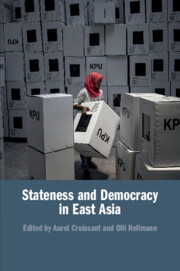Book contents
- Stateness and Democracy in East Asia
- Stateness and Democracy in East Asia
- Copyright page
- Contents
- Figures
- Tables
- Contributors
- Acknowledgements
- 1 Introduction: Rethinking Stateness and Democracy in East Asia
- 2 State-Building and Democratization
- 3 South Korea’s Democracy and the Legacies of the Developmental State
- 4 After Hegemony: State Capacity, the Quality of Democracy and the Legacies of the Party-State in Democratic Taiwan
- 5 Democratization Interrupted: The Parallel State and the Demise of Democracy in Thailand
- 6 Weak State and the Limits of Democratization in Cambodia, 1993–2017
- 7 The Institutional Roots of Defective Democracy in the Philippines
- 8 Stateness and State Capacity in Post-Authoritarian Indonesia: Securing Democracy’s Survival, Entrenching Its Low Quality
- 9 As Good as It Gets? Stateness and Democracy in East Timor
- 10 Stateness and Democracy: Evidence from East Asia and Cross-Regional Comparisons
- Index
- References
4 - After Hegemony: State Capacity, the Quality of Democracy and the Legacies of the Party-State in Democratic Taiwan
Published online by Cambridge University Press: 13 May 2020
- Stateness and Democracy in East Asia
- Stateness and Democracy in East Asia
- Copyright page
- Contents
- Figures
- Tables
- Contributors
- Acknowledgements
- 1 Introduction: Rethinking Stateness and Democracy in East Asia
- 2 State-Building and Democratization
- 3 South Korea’s Democracy and the Legacies of the Developmental State
- 4 After Hegemony: State Capacity, the Quality of Democracy and the Legacies of the Party-State in Democratic Taiwan
- 5 Democratization Interrupted: The Parallel State and the Demise of Democracy in Thailand
- 6 Weak State and the Limits of Democratization in Cambodia, 1993–2017
- 7 The Institutional Roots of Defective Democracy in the Philippines
- 8 Stateness and State Capacity in Post-Authoritarian Indonesia: Securing Democracy’s Survival, Entrenching Its Low Quality
- 9 As Good as It Gets? Stateness and Democracy in East Timor
- 10 Stateness and Democracy: Evidence from East Asia and Cross-Regional Comparisons
- Index
- References
Summary
At the beginning of the democratic era, the state in Taiwan had at least four distinct features that set it apart from the other cases in this volume: a ‘bifurcation’ between a high capacity, high autonomy central government and deeply socially embedded local governments, a fused ‘party-state’ regime, a vibrant but fragmented and shallowly rooted civil society sector and a business community with only limited influence over the central government. These features have together shaped a distinct kind of democratic political regime in Taiwan. On the positive side, Taiwan’s civilian leaders enjoy uncircumscribed authority over all parts of the state, national elections now confer on their winners the fully effective right to rule, elections are well-managed, the party system is highly institutionalized and the full array of political rights are broadly respected. On the less positive side, Taiwan’s civil rights regime continues to suffer from weak legal foundations, and horizontal accountability has been incompletely institutionalized despite the regime’s formal separation of powers. Thus, Taiwan’s highly developed hegemonic party-state appears at best to have had no effect on and, at worst, actively undermined the establishment of a robust rule of law and protections for civil liberties.
Keywords
- Type
- Chapter
- Information
- Stateness and Democracy in East Asia , pp. 71 - 102Publisher: Cambridge University PressPrint publication year: 2020
References
- 3
- Cited by



